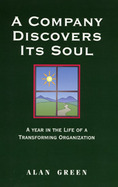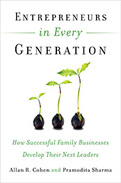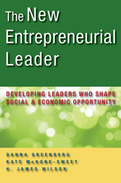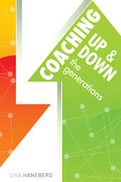A Company Discovers Its Soul is the engaging story of a year in the life of a fictional, yet true-to-life company as it undergoes profound transformation. Grounded in the author's own experiences in organizations, it is a tale that probes deeply into the "soul issues" of organizational life and offers an inspiring and realistic portrayal of how new principles and concepts evolve in everyday business reality.
Randall Hawkes was trained in modern business schools and is CEO of a company founded by his grandfather-a traditional, hierarchical organization that is facing decreasing profits, low morale, and competitors that are taking market share. Recognizing that the managerial techniques he learned in school are now producing dis-ease in himself, his family, his staff, and the organization, Randall becomes convinced that some kind of radical change must be made. Exploring the gradual changes in Randall's own thinking and way of leading the company, A Company Discovers Its Soul illustrates how such a process of change might happen. It shows how-through a combination of humility, courage, rigorous self- and mutual appraisal, and practice-Randall and his staff gradually learn to see the Hawkes Company as a living community.
Most important to this change process is Randall's own change in perception and thinking regarding his role in the organization and his notions about control, ownership, information sharing-and the resulting freedom for his staff, and everyone in the organization, to be more powerful and creative. By the end of the first year of this journey, The Hawkes Company staff has become more strongly aligned around their purpose and vision, the management team has truly become a team, relationships with suppliers and customers have been strengthened, and even their work environments have been improved as employees have taken ownership for maintaining their working spaces, and the plant in general.
Author Alan Green examines the changes that take place in the lives of the company's top management as they struggle to achieve greater effectiveness previously prevented by their control-oriented, narrowly functional roles. Readers will learn along with Randall as he combines the roles of servant, steward, partner, and leader in an effort to create an organizational culture that fosters creativity, cooperation, and resiliency.
- A true-to-life story that addresses the real issues that businesses struggle with every day
- Clearly distinguishes between real transformation and simply learning a new vocabulary
Families are complicated; family businesses even more so. Like other companies, family-run enterprises must develop leadership and entrepreneurial skills. But they must also manage family dynamics that rarely mirror the best practices in the latest Harvard Business Review.
Allan Cohen and Pramodita Sharma, scholars with deep professional and personal roots in family businesses, show how enterprising families can transmit the hunger for excellence across generations. Using examples of firms that flourished and those that failed, they describe the practices that characterize entrepreneurial individuals, families, and organizations and offer pragmatic advice that can be tailored to your unique situation.
Shares in Microsoft, the world's largest computer software firm, changed hands at an average price of $70 during 1995, at a time when their "book value" or "equity" was just $7. In other words, for every $1 of tangible value, the market saw $9 of additional value, for which there was no corresponding record in Microsoft's balance sheet. This extra $9 in the value of Microsoft shares represents a major trend. More and more, companies are deriving value from their intangible assets. These assets include their employee's creative ideas, their customers' loyalty, their ability to attract and keep prestigious accounts, their innovative products and services, their popular brand names, and their reputation.
Knowledge-based organizations with intangible assets, such as accounting and legal firms, management consultants, advertising agencies, medical clinics and hospitals, software and engineering companies, and the art and entertainment industry make up the fastest growing business sector. Yet few of these companies achieve their potential performance and profitability because they do not know how to exploit their intangible assets. They measure performance only in terms of money, ignoring less tangible but vital assets such as the ability to capture high profile customers or the creativity to keep the company on the cutting edge with innovative products or services.
The New Organizational Wealth shows how some of the fastest-growing, most profitable companies are discovering that potentially limitless revenues can flow from their firm's intangible assets-the ability of employees, customers, and even suppliers to create new concepts, models, products, and services. Among the book's many examples is Netscape Communications. This successful company demonstrates the profitable results of fostering long-term customer relationships and the effectiveness of investing in employee competence to maintain a rich pool of talent.
The New Organizational Wealth outlines the conceptual framework for changing business strategies to focus on intangible assets. Using its guidelines, managers can learn how to identify the indicators for their company's intangible assets-their employee's talents and strengths, their customers' support and interest, and their supplier's reliability and ingenuity. Specific chapters detail how to effectively use and measure these "tacit" assets, as well as how to monitor them for financial success. Helpful case studies of Scandanavian companies such as WM-data-s, Skandia AFS, and Celemi, which have developed systems for measuring intangible assets and publicly reporting the results, provide models managers can use in leading their companies to increased profitability and long-term organizational success.
- The first book on managing and measuring intangible assets
- Shows how to tap customer and employee knowledge to build a more successful organization
- Provides tools for measuring such intangible assets as competent and creative employees, patents, brand names, or company reputation
- Written by an experienced manager who played a key role in developing the "Scandinavian Movement" of management
Describes three principles that form the basis for entrepreneurial leadership, a new leadership approach for today's world
In years past, the keywords for leaders were confidence, single-minded purpose, and strategic planning. But today’s vastly complex, globalized, and fast-evolving world requires a different kind of leadership. This game-changing book details a new approach—entrepreneurial leadership—developed at Babson College, the number-one school for entrepreneurship in the world. Entrepreneurial leadership is inspired by, but is separate from, entrepreneurship. It can be applied in any organizational situation, not just start-ups. Based on two years of extensive research, it embraces three principles that add up to a fundamentally new worldview of business and a new logic of decision making. First, rapid change and increasing uncertainty require leaders to be “cognitively ambidextrous,” able to shift between traditional “prediction logic” (choosing actions based on analysis) and “creation logic” (taking action despite considerable unknowns). Guiding this different way of thinking and acting is a new view of business, where simultaneous creation of social, environmental, and economic value is the order of the day. Finally, entrepreneurial leaders leverage their understanding of themselves and their social context to guide effective action. Each chapter offers concrete examples of how educators across all disciplines are integrating these ideas into their courses—and even their entire curricula. The New Entrepreneurial Leader lays out a comprehensive new paradigm for reinventing management education in order to mold leaders who will shape social and economic opportunity.
-
Offers a complete, concise overview of how each generation -- The Traditionalists, the Boomers, Gen X and Gen Y -- view life, technology, work, communication and behavior
-
Shows that coaching can be more effective if it is a dynamic, interactive process, not a sterile set of practices imposed by a coach on a performer
-
Creates enthusiastic cross-generational communication and relationship-building
"Coaching," Lisa Haneberg says, "is agile, service-oriented persistence with a tolerance for the unexplainable and a willingness to go down a path that is not yours, does not interest you, and requires that you buy new shoes to traverse unharmed." This tongue-in-cheek description suggests the fun and breezy tone of this book. This is most decidedly not just another book about generational differences, nor is it yet another "how to coach" book. Coaching Up and Down the Generations looks at the key processes of transferring knowledge, developing teams, and collaborating, and examines how different age groups can better learn from one another and even experience major breakthroughs that will improve their progress -- despite disparate backgrounds.
You'll find a thorough examination of key issues in inter-generational coaching situations, including what constitutes great coaching, at any age; a complete overview of each generation and how they view life, technology, work, communication, and behavior; how to handle clashing communication styles and preferences; the importance of "coachability" in yourself and others regardless of different habits, opininos, and work styles; how to cultivate a coaching environment where the different generations can have provocative conversations and truly help one another.
With this book as your guide, you can show the generations how to find common points of interest, needs, and goals. You'll find ingenious tips for creating formal and informal coaching situations, developing opportunities to build relationships, and helping people of all ages to become catalytic coaches and engaged performers.
-
Offers a complete, concise overview of how each generation -- The Traditionalists, the Boomers, Gen X and Gen Y -- view life, technology, work, communication and behavior
-
Shows that coaching can be more effective if it is a dynamic, interactive process, not a sterile set of practices imposed by a coach on a performer
-
Creates enthusiastic cross-generational communication and relationship-building
"Coaching," Lisa Haneberg says, "is agile, service-oriented persistence with a tolerance for the unexplainable and a willingness to go down a path that is not yours, does not interest you, and requires that you buy new shoes to traverse unharmed." This tongue-in-cheek description suggests the fun and breezy tone of this book. This is most decidedly not just another book about generational differences, nor is it yet another "how to coach" book. Coaching Up and Down the Generations looks at the key processes of transferring knowledge, developing teams, and collaborating, and examines how different age groups can better learn from one another and even experience major breakthroughs that will improve their progress -- despite disparate backgrounds.
You'll find a thorough examination of key issues in inter-generational coaching situations, including what constitutes great coaching, at any age; a complete overview of each generation and how they view life, technology, work, communication, and behavior; how to handle clashing communication styles and preferences; the importance of "coachability" in yourself and others regardless of different habits, opininos, and work styles; how to cultivate a coaching environment where the different generations can have provocative conversations and truly help one another.
With this book as your guide, you can show the generations how to find common points of interest, needs, and goals. You'll find ingenious tips for creating formal and informal coaching situations, developing opportunities to build relationships, and helping people of all ages to become catalytic coaches and engaged performers.
If you want to have a career that is meaningful and inspires you, you must prepare for it the same way you would a marathon—developing an overall training plan to carry you through to race day and beyond. This is especially important in today's unpredictable work world, where organizations are in a state of constant flux, and many have either eliminated their employee development programs or adopted a generic, one-size-fits-all approach.
Skills for Career Success maps the strategies and skills you will need to take responsibility for your own future. It provides an overview of career development basics, including how to write an Individual Development Plan (IDP) that is practical and useful to you. The core of the book is an easy-to-navigate catalog of fifty-one critical skills, such as communicating clearly, adapting to situations, advocating for yourself, managing time, and selling your ideas. For each skill, there are actions you can take immediately, ongoing practices, and long-term goals. Beyond the skills, there is advice for keeping your career on track, mapping a path beyond your current job, overcoming personal roadblocks, finding your passion at work, and initiating talent conversations with your manager. There are also guidelines for managers who want to bring out the best in their people.


























